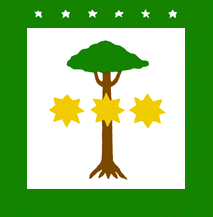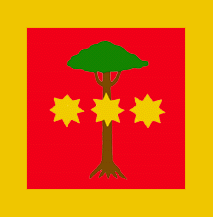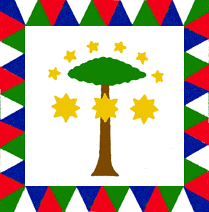

 Images by Jaume Ollé, 01 July 1997
Images by Jaume Ollé, 01 July 1997
Last modified: 2019-01-03 by bruce berry
Keywords: equatorial guinea | president | proposal |
Links: FOTW homepage |
search |
disclaimer and copyright |
write us |
mirrors
Currently there is no presidential flag in Equatorial Guinea.


 Images by Jaume Ollé, 01 July 1997
Images by Jaume Ollé, 01 July 1997
In 1986 the presidency of the Equatorial Guinea requested proposals for the
design of a presidential standard. Tomas Rodriguez and Antonio Manzano made three proposals that were presented to Teorodo Obiang Nguema Mbasogo. I don't know if anyone was
chosen because relations between Spain and Equatorial Guinea cooled afterwards.
In the three proposed designs there were three colonel stars relating to the grade that
President Obiang had in the army (in the Spanish army I suppose, since he obtained his title in Spain). The six stars are not explained, but they should correspond to the districts. The tree, whose name in English do not know (in Spanish is "CEIBA") figure in the national shield. In the design one of red background is mentioned that the tree and the stars were bordered by some branches of cocoa plant, but was not published their design.
Source: Moharra Number 2, September 1986.
Jaume Ollé, 1 July 1997
There is currently no Presidential standard in Equatorial Guinea.
However, in 1986 the Presidency of the Equatorial Guinea requested the design for a presidential standard. Tomas Rodriguez and Antonio Manzano make three proposals that were presented to the then President, Teorodo Obiang Nguema Mbasogo.
The proposals all featured the silk cotton tree (Ceiba
in Spanish) from the national Arms with three yellow "colonel" stars to signify
the rank of President Obiang in the army (in the Spanish army I suppose, since he obtained his title in Spain). The six stars are not explained, but they
could correspond to the country's districts or the pieces of territory which
together make up the country.
Source: Moharra number 2, September 1986.
Jaume Ollé, 01 July 1997